The Incorporation of Ladle Furnace Slag in Fire Insulating Gypsum-Based Materials
Abstract
:1. Introduction
2. Materials and Methods
2.1. Materials and Tested Mixtures
2.2. Chemical, Mineralogical, and Physical Properties
2.3. Mechanical Properties
2.4. Fire Insulating Capacity
2.5. Differential Scanning Calorimetry (DSC) Test
2.6. Leaching Test
3. Results and Discussion
3.1. Ladle Slag Characterization
3.2. Physical Characterization of the Mixtures
3.3. Mechanical Characterization of the Mixtures
3.4. Fire Insulating Capacity
3.5. Leaching Results
| Element | Ladle Slag | Gypsum | Catalonia and Cantabria Limits | Basque Country Limit | Inert Waste | Non-Hazardous Waste |
|---|---|---|---|---|---|---|
| Zn | 0.32 | <0.25 | 4 | 1.2 | 4 | 50 |
| V | <0.05 | <0.05 | - | 1.3 | - | - |
| Se | <0.25 | <0.02 | 0.1 | 0.007 | 0.1 | 0.5 |
| Pb | <0.1 | <0.1 | 0.5 | - | 0.5 | 10 |
| Ni | <0.05 | <0.05 | 0.4 | 0.8 | 0.4 | 10 |
| Mo | <0.1 | <0.1 | 0.5 | 1.3 | 0.5 | 10 |
| Hg | <0.01 | <0.01 | 0.01 | - | 0.01 | 0.2 |
| Sb | <0.1 | <0.05 | 0.06 | - | 0.06 | 0.7 |
| Cu | 0.073 | <0.05 | 2 | - | 2 | 50 |
| Cr | <0.05 | <0.05 | 0.5 | 2.6 | 0.5 | 10 |
| Co | <0.05 | <0.05 | - | - | - | - |
| Cd | <0.02 | <0.02 | 0.04 | 0.009 | 0.04 | 1 |
| Ba | 11.2 | 0.6 | 20 | 17 | 20 | 100 |
| As | <0.25 | <0.25 | 0.5 | - | 0.5 | 2 |
4. Conclusions
- In terms of physical characteristics, the substitution of gypsum with ladle slag leads to a reduction in density due to its higher specific gravity.
- In terms of mechanical standpoint, the incorporation of ladle slag has a diminishing effect on mechanical properties. Dosages equal to lower than 60%wt of ladle slag exhibit compressive strengths exceeding 2 MPa. The surface hardness exceeds the limit for high-density materials in compositions with a ladle slag content lower than 50%, which represents the only restriction concerning ladle slag recycling.
- The compressive strength decreases with increasing temperatures, but the reduction in compressive strength at elevated temperatures is proportionally lower when the slag content is higher.
- The fire insulating capacity of the mixtures diminishes as the proportion of slag increases, although the inclusion of ladle slag exhibits some positive influence on its fire insulating capacity due to certain endothermic processes (resulting in a 20% reduction when 60% weight of slag is used). Notably, no gas emissions were observed during the fire test.
- Ladle slag can be effectively used as a component in construction materials, in terms of heavy metals leaching.
Author Contributions
Funding
Institutional Review Board Statement
Informed Consent Statement
Data Availability Statement
Conflicts of Interest
References
- Steel Statistical Yearbook 2020 Concise Version, World Steel Association. 2020. Available online: https://worldsteel.org/wp-content/uploads/Steel-Statistical-Yearbook-2020-concise-version.pdf (accessed on 19 September 2023).
- Wu, L.; Li, H.; Mei, H.; Rao, L.; Wang, H.; Lv, N. Generation, utilization, and environmental impact of ladle furnace slag: A minor review. Sci. Total Environ. 2023, 895, 165070. [Google Scholar] [CrossRef] [PubMed]
- Shi, C. Characteristics and cementitious properties of ladle slag fines from steel production. Cem. Concr. Res. 2002, 32, 459–462. [Google Scholar] [CrossRef]
- Pachta, V.; Anastasiou, E.K. Utilization of industrial byproducts for enhancing the properties of cement mortars at elevated temperatures. Sustainability 2021, 13, 12104. [Google Scholar] [CrossRef]
- Santamaría, A.; Ortega-López, V.; Skaf, M.; Faleschini, F.; Orbe, A.; San-José, J.T. 23—Ladle furnace slags for construction and civil works: A promising reality. In Waste and Byproducts in Cement-Based Materials—Innovative Sustainable Materials for a Circular Economy; de Brito, J., Thomas, C., Medina, C., Agrela, F., Eds.; Woodhead Publishing: Cambridge, UK, 2021; pp. 659–679. [Google Scholar] [CrossRef]
- Pasetto, M.; Baliello, A.; Giacomello, G.; Pasquini, E. The use of steel slags in asphalt pavements: A state-of-the-art review. Sustainability 2023, 15, 8817. [Google Scholar] [CrossRef]
- Skaf, M.; Ortega-Lopez, V.; Fuente-Alonso, J.A.; Santamaria, A.; Manso, J.M. Ladle furnace slag in asphalt mixes. Constr. Build. Mater. 2016, 122, 488–495. [Google Scholar] [CrossRef]
- Shih, P.-H.; Chang, Y.-K.; Dai, H.-A.; Chiang, L.-C. Porous fire-resistant materials made from alkali-activated electric arc furnace ladle slag. Processes 2022, 10, 638. [Google Scholar] [CrossRef]
- Gómez-Casero, M.Á.; Pérez-Villarejo, L.; Sánchez-Soto, P.J.; Eliche-Quesada, D. Alkali activated cements based on slags from different industries. Mater. Proc. 2022, 8, 123. [Google Scholar] [CrossRef]
- Rodriguez, A.; Manso, J.M.; Aragón, Á.; González, J.J. Strength and workability of masonry mortars manufactured with ladle furnace slag. Resour. Conserv. Recycl. 2009, 53, 645–651. [Google Scholar] [CrossRef]
- Montenegro, J.M.; Celemín-Matachana, M.; Cañizal, J.; Setién, J. Ladle furnace slag in the construction of embankments: Expansive behavior. J. Mater. Civ. Eng. 2013, 25, 972–979. [Google Scholar] [CrossRef]
- Ghisman, V.; Muresan, A.C.; Buruiana, D.L.; Axente, E.R. Waste slag benefits for correction of soil acidity. Sci. Rep. 2022, 12, 16042. [Google Scholar] [CrossRef]
- Setién, J.; Hernández, D.; González, J.J. Characterization of ladle furnace basic slag for use as a construction material. Constr. Build. Mater. 2009, 23, 1788–1794. [Google Scholar] [CrossRef]
- Yew, M.C.; Yew, M.K.; Yuen, R.K.K. Experimental analysis of lightweight fire-rated board on fire resistance, mechanical, and acoustic properties. Fire 2023, 6, 221. [Google Scholar] [CrossRef]
- Vilches, L.F.; Leiva, C.; Vale, J.; Fernández-Pereira, C. Insulating capacity of fly ash pastes used for passive protection against fire. Cem. Concr. Compos. 2005, 27, 776–781. [Google Scholar] [CrossRef]
- Vilches, L.F.; Leiva, C.; Olivares, J.; Vale, J.; Fernández, C. Coal fly ash-containing sprayed mortar for passive fire protection of steel sections. Mater. Constr. 2005, 55, 25–37. [Google Scholar] [CrossRef]
- García Arenas, C.; Marrero, M.; Leiva, C.; Solís-Guzmán, J.; Vilches Arenas, L.F. High fire resistance in blocks containing coal combustion fly ashes and bottom ash. Waste Manag. 2011, 31, 1783–1789. [Google Scholar] [CrossRef]
- Peceño, B.; Pérez-Soriano, E.M.; Ríos, J.D.; Luna, Y.; Cifuentes, H.; Leiva, C. Effect of different ashes from biomass olive pomace on the mechanical and fire properties of gypsum-based materials. Rev. Constr. 2023, 22, 122–134. [Google Scholar] [CrossRef]
- Leiva, C.; Vilches, L.F.; Vale, J.; Fernández-Pereira, C. Fire resistance of biomass ash panels used for internal partitions in buildings. Fire Saf. J. 2009, 44, 622–628. [Google Scholar] [CrossRef]
- Gutiérrez-González, S.; Gadea, J.; Rodríguez, A.; Blanco-Varela, M.T.; Calderón, V. Compatibility between gypsum and polyamide powder waste to produce lightweight plaster with enhanced thermal properties. Constr. Build. Mater. 2012, 34, 179–185. [Google Scholar] [CrossRef]
- Peceño, B.; Alonso-Fariñas, B.; Vilches, L.F.; Leiva, C. Study of seashell waste recycling in fireproofing material: Technical, environmental, and economic assessment. Sci. Total Environ. 2021, 790, 148102. [Google Scholar] [CrossRef]
- Salazar, P.A.; Fernández, C.L.; Luna-Galiano, Y.; Sánchez, R.V.; Fernández-Pereira, C. Physical, mechanical and radiological characteristics of a fly ash geopolymer incorporating titanium dioxide waste as passive fire insulating material in steel structures. Materials 2022, 15, 8493. [Google Scholar] [CrossRef]
- Ríos, J.D.; Arenas, C.; Cifuentes, H.; Vilches, L.F.; Leiva, C. Development of a paste for passive fire protection mainly composed of granulated blast furnace slag. Environ. Prog. Sustain. Energy 2020, 39, e13382. [Google Scholar] [CrossRef]
- Gutiérrez-González, S.; Gadea, J.; Rodríguez, A.; Junco, C.; Calderón, V. Lightweight plaster materials with enhanced thermal properties made with polyurethane foam wastes. Constr. Build. Mater. 2012, 28, 653–658. [Google Scholar] [CrossRef]
- Alonso, A.; Rodríguez, A.; Gadea, J.; Gutiérrez-González, S.; Calderón, V. Impact of plasterboard with ladle furnace slag on fire reaction and thermal behavior. Fire Technol. 2019, 55, 1733–1751. [Google Scholar] [CrossRef]
- EN 13279-1:2009; Gypsum Binders and Gypsum Plasters—Part 1: Definitions and Requirements. European Committee for Standardization (CEN): Brussels, Belgium, 2009. [CrossRef]
- UNE-EN 1097-3:1999; Tests for Mechanical and Physical Properties of Aggregates—Part 3: Determination of Loose Bulk Density and Voids. Spanish Association for Standardization and Certification (UNE): Madrid, Spain, 1999.
- EN 12859:2012; Gypsum Blocks—Definitions, Requirements and Test Methods. Spanish Association for Standardization and Certification (UNE): Madrid, Spain, 2012.
- ASTM E761/E761M-92(2020); Standard Test Method for Compressive Strength of Sprayed Fire-Resistive Material Applied to Structural Members. American Society for Testing and Materials: West Conshohocken, PA, USA, 2020.
- EN 1363-1:2021; Fire Resistance Tests—Part 1: General Requirements. Spanish Association for Standardization and Certification (UNE): Madrid, Spain, 2021.
- Serjun, V.Z.; Mladenovic, A.; Mirtič, B.; Meden, A.; Ščančar, J.; Milačič, R. Recycling of ladle slag in cement composites: Environmental impacts. Waste Manag. 2015, 43, 376–385. [Google Scholar] [CrossRef]
- EN 12457-4:2003; Characterisation of Waste—Leaching—Compliance Test for Leaching of Granular Waste Materials and Sludges—Part 4: One Stage Batch Test at a Liquid to Solid Ratio of 10 L/kg for Materials with Particle Size Below 10 mm (without or with Size Reduction). Spanish Association for Standardization and Certification (UNE): Madrid, Spain, 2003.
- Aponte, D.; Soto Martín, O.; Valls del Barrio, S.; Barra Bizinotto, M. Ladle steel slag in activated systems for construction use. Minerals 2020, 10, 687. [Google Scholar] [CrossRef]
- EN 1097-7:2009; Tests for Mechanical and Physical Properties of Aggregates—Part 7: Determination of the Particle Density of Filler—Pyknometer Method. Spanish Association for Standardization and Certification (UNE): Madrid, Spain, 2009.
- Luo, Y.; Klima, K.M.; Brouwers, H.J.H.; Yu, Y. Effects of ladle slag on Class F fly ash geopolymer: Reaction mechanism and high temperature behavior. Cem. Concr. Compos. 2022, 129, 104468. [Google Scholar] [CrossRef]
- Adesanya, E.; Sreenivasan, H.; Kantola, A.M.; Telkki, V.-V.; Ohenoja, K.; Kinnunen, P.; Illikainen, M. Ladle slag cement—Characterization of hydration and conversion. Constr. Build. Mater. 2018, 193, 128–134. [Google Scholar] [CrossRef]
- Leiva, C.; García Arenas, C.; Vilches, L.F.; Vale, J.; Gimenez, A.; Ballesteros, J.C.; Fernández-Pereira, C. Use of FGD gypsum in fire resistant panels. Waste Manag. 2010, 30, 1123–1129. [Google Scholar] [CrossRef] [PubMed]
- Council Directive 1999/31/EC of 26 April 1999 on the Landfill of Waste. Official Journal L 182, 16/07/1999 P. 0001–0019. European Commission, 1999. Available online: http://data.europa.eu/eli/dir/1999/31/oj (accessed on 19 September 2023).
- DL 183/2009 Waste Disposal at Landfills. Transposition to the Portuguese Law of Council. Directive 1999/31/CE, April 26. Portuguese Mint and Official Printing Office: Lisbon, Portugal, 2009.
- Decreto 34 del País Vasco Por el Que Se Regula la Valorización y Posterior Utilización de Escorias Procedentes de la Fabricación de Acero en Hornos de arco Eléctrico, en el Ámbito de la Comunidad Autónoma del País Vasco. País Vasco, Spain. 2003. Available online: https://www.legegunea.euskadi.eus/eli/es-pv/d/2003/02/18/34/dof/spa/html/webleg00-contfich/es/ (accessed on 19 September 2023).
- Decreto 32/2009 de 24 de Febrero Sobre la Valorización de Escorias Siderúrgicas; Generalitat de Catalunya: Barcelona, Spain, 2009; Available online: http://www.arc.cat/es/publicacions/pdf/normativa/catalana/decrets/decret_32_2009.pdf (accessed on 19 September 2023).
- Decreto 100/2018 de Valorización de Escorias en la Comunidad Autónoma de Cantabria. Cantabria, Spain. 2019. Available online: https://boc.cantabria.es/boces/verAnuncioAction.do?idAnuBlob=333876 (accessed on 19 September 2023).



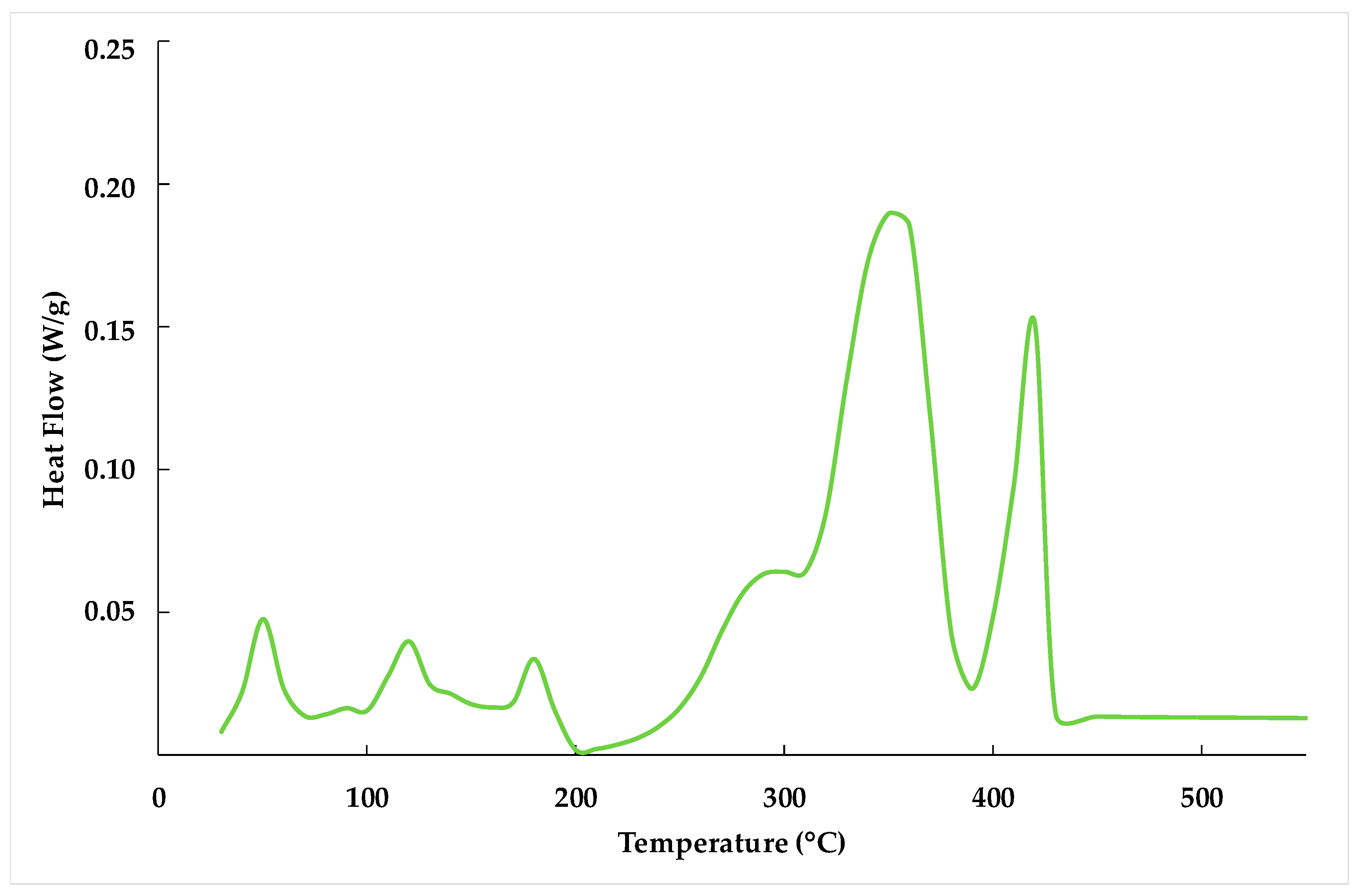
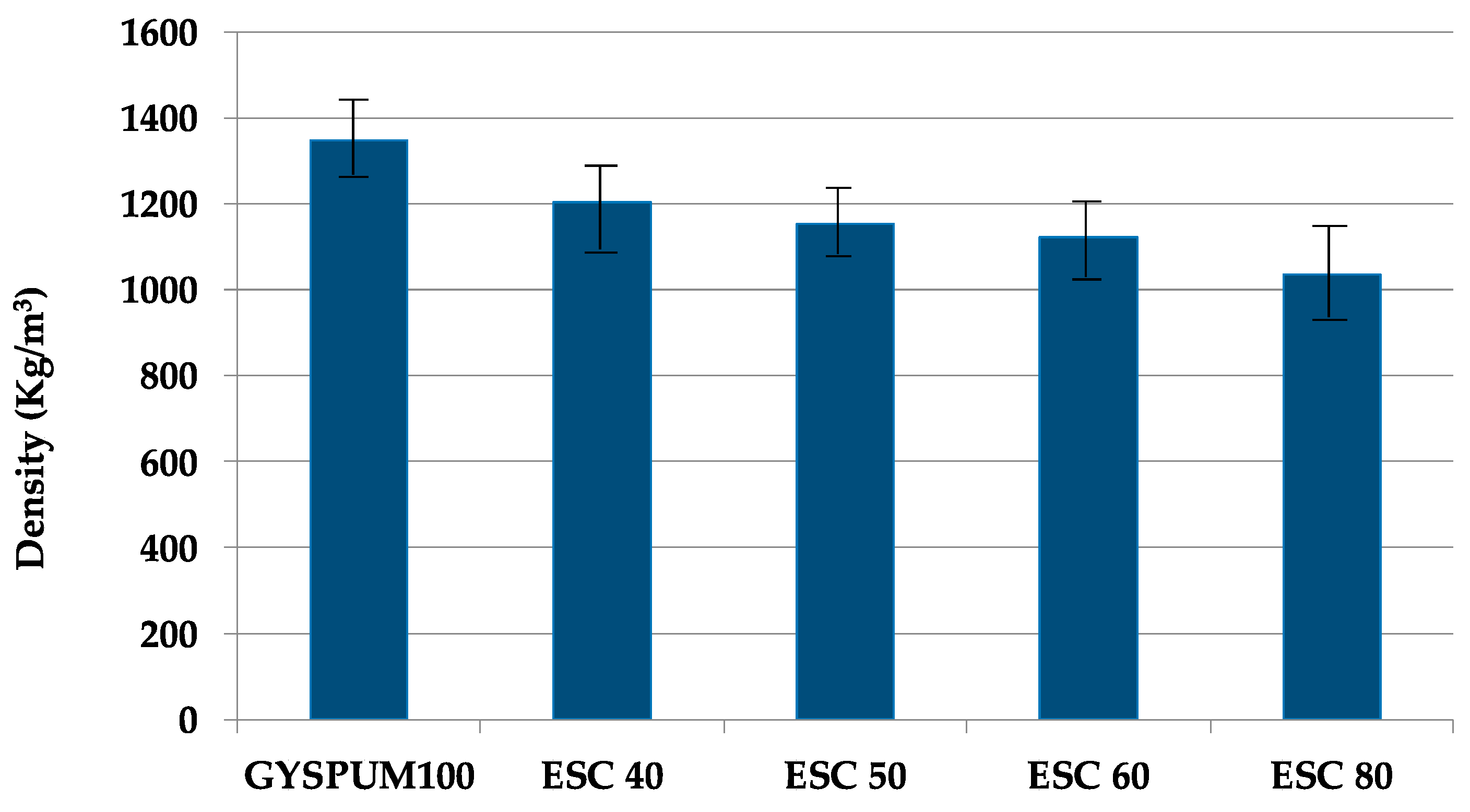
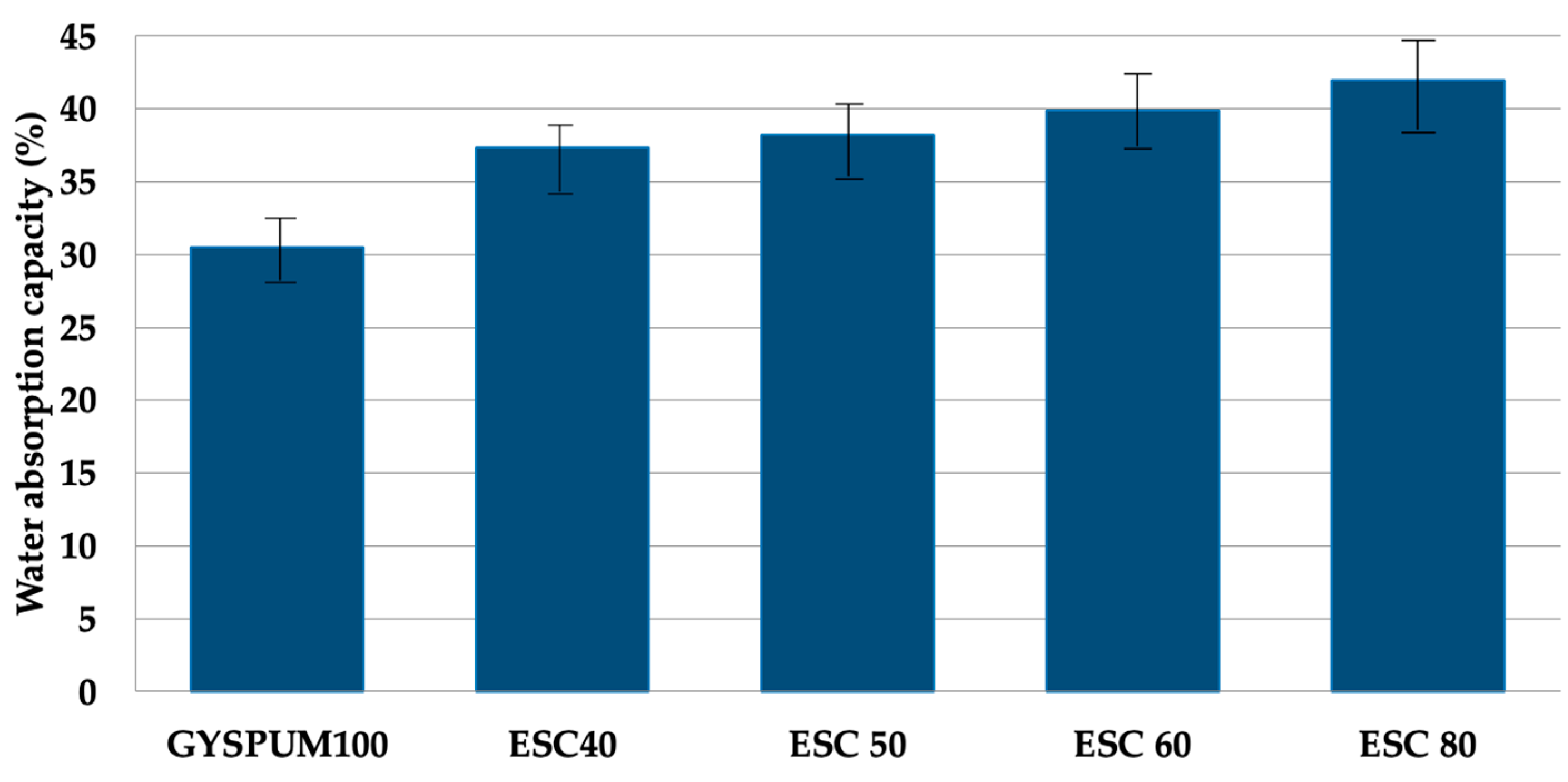
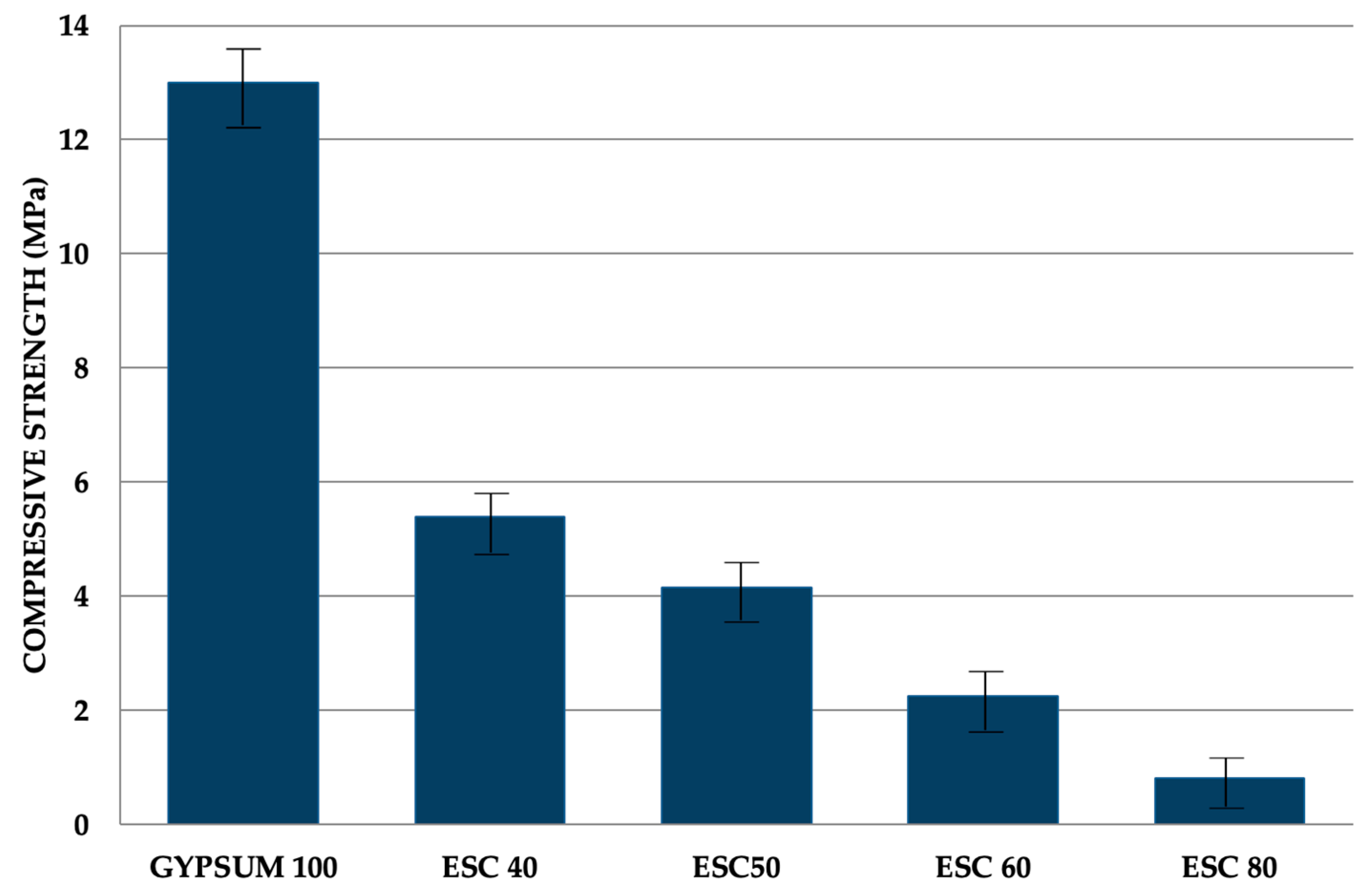
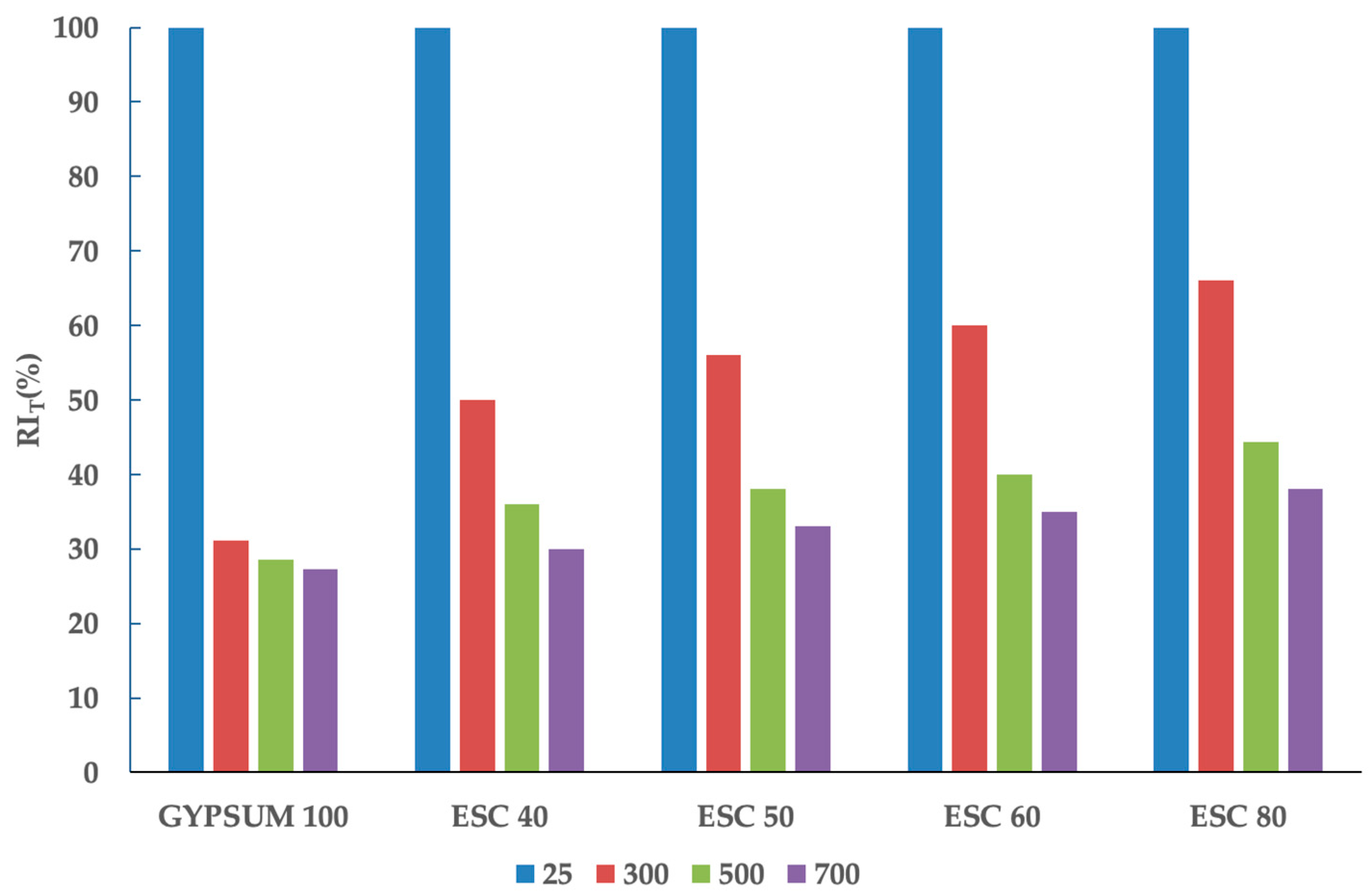
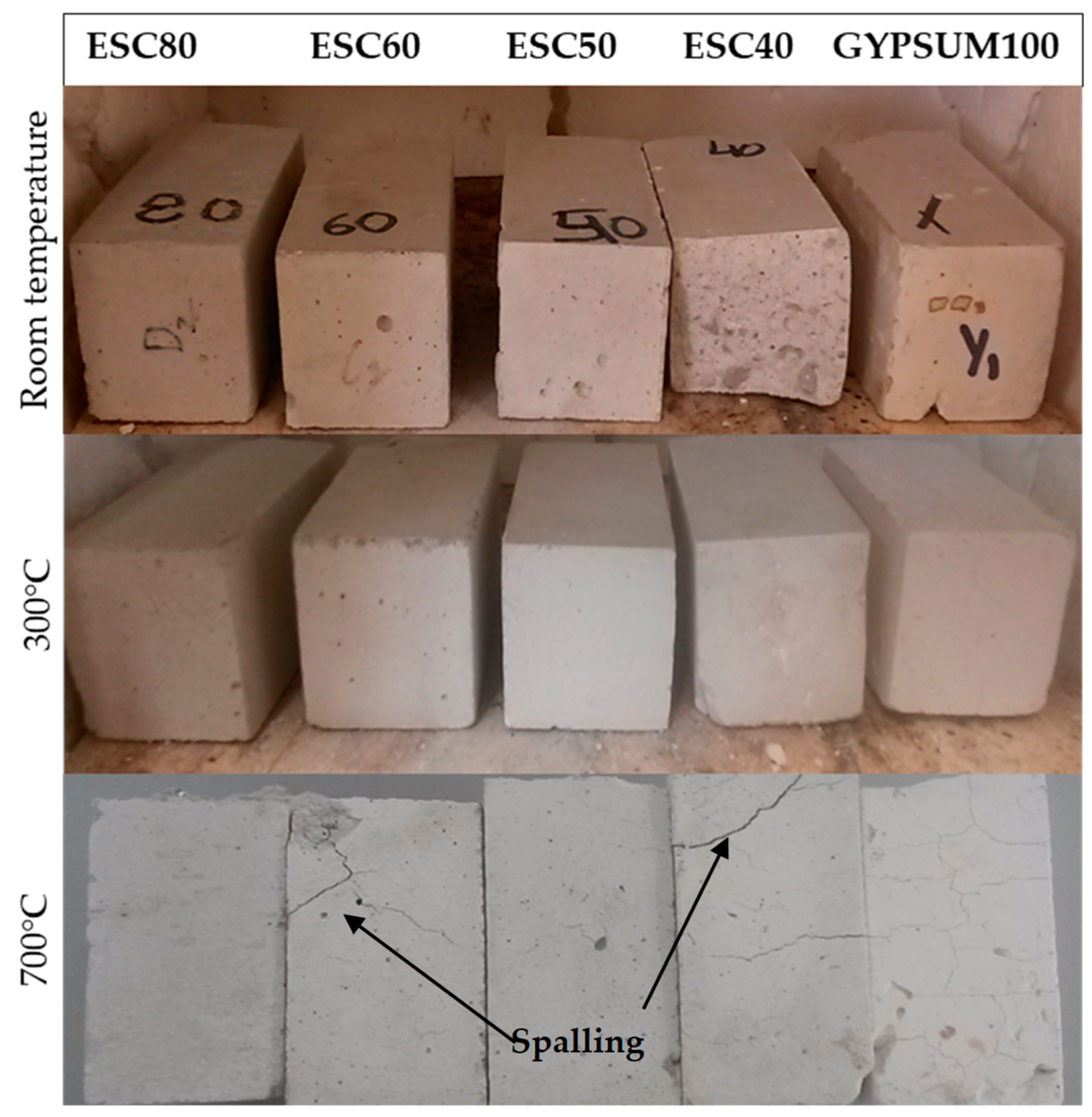


| Sample | Gypsum [%wt] | Laddle Slag [%wt] | Water/Solid Ratio |
|---|---|---|---|
| Gypsum | 100 | 0 | 0.45 |
| ESC 40 | 60 | 40 | 0.42 |
| ESC 50 | 50 | 50 | 0.41 |
| ESC 60 | 40 | 60 | 0.40 |
| ESC 80 | 20 | 80 | 0.39 |
| Major Components | [%wt] | Minor Components | [ppm] |
|---|---|---|---|
| SiO2 | 15.03 | S | 133.56 |
| Fe2O3 | 2.33 | Cr | 28.25 |
| FeO | 1.08 | P | 4.31 |
| Al2O3 | 6.23 | Zn | 293 |
| CaO | 45.20 | Ti | 41.74 |
| MgO | 13.35 | Sr | 3.05 |
| MnO | 1.48 | Cu | 180 |
| Loss on ignition | 14.16 | Cl | 22.61 |
| Specific gravity | 2.88 | Ba | 292 |
| data | Pb | 72 |
Disclaimer/Publisher’s Note: The statements, opinions and data contained in all publications are solely those of the individual author(s) and contributor(s) and not of MDPI and/or the editor(s). MDPI and/or the editor(s) disclaim responsibility for any injury to people or property resulting from any ideas, methods, instructions or products referred to in the content. |
© 2023 by the authors. Licensee MDPI, Basel, Switzerland. This article is an open access article distributed under the terms and conditions of the Creative Commons Attribution (CC BY) license (https://creativecommons.org/licenses/by/4.0/).
Share and Cite
Peceño, B.; Pérez-Soriano, E.M.; Luna-Galiano, Y.; Leiva, C. The Incorporation of Ladle Furnace Slag in Fire Insulating Gypsum-Based Materials. Fire 2023, 6, 416. https://doi.org/10.3390/fire6110416
Peceño B, Pérez-Soriano EM, Luna-Galiano Y, Leiva C. The Incorporation of Ladle Furnace Slag in Fire Insulating Gypsum-Based Materials. Fire. 2023; 6(11):416. https://doi.org/10.3390/fire6110416
Chicago/Turabian StylePeceño, Begoña, Eva M. Pérez-Soriano, Yolanda Luna-Galiano, and Carlos Leiva. 2023. "The Incorporation of Ladle Furnace Slag in Fire Insulating Gypsum-Based Materials" Fire 6, no. 11: 416. https://doi.org/10.3390/fire6110416
APA StylePeceño, B., Pérez-Soriano, E. M., Luna-Galiano, Y., & Leiva, C. (2023). The Incorporation of Ladle Furnace Slag in Fire Insulating Gypsum-Based Materials. Fire, 6(11), 416. https://doi.org/10.3390/fire6110416









